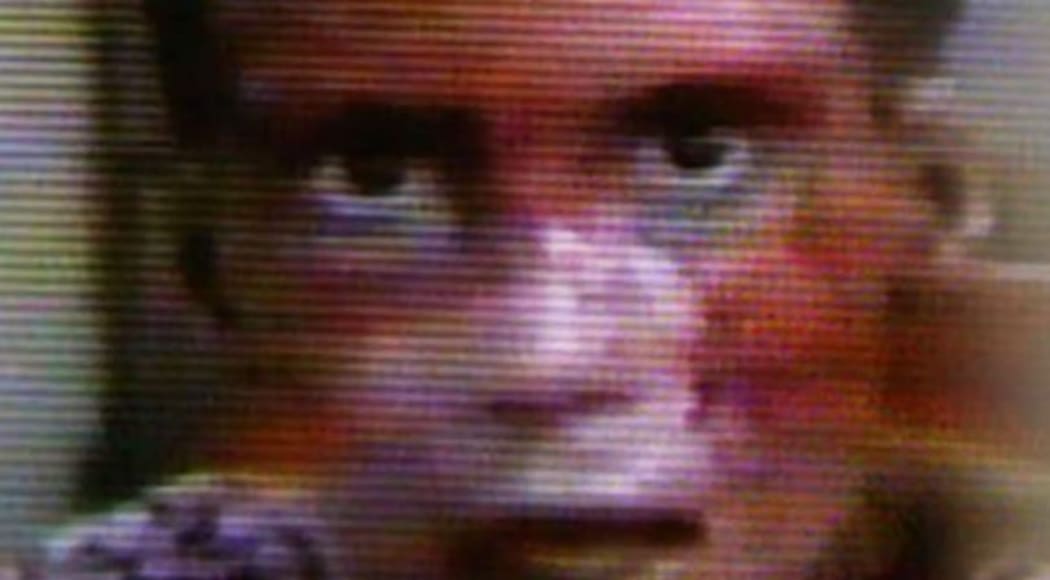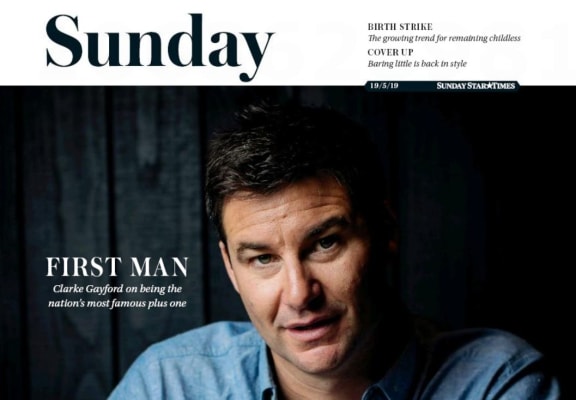Mediawatch's weekly catch-up with Lately. Colin Peacock talks to Emile Donovan about media self-obsession, an awful Aussie election gimmick; two lost-and-found tearjerkers; a spoiled spoiler story - and media people with their eyes on the prizes.

A harrowing image from The Boy in the Photo - a lost and found story with a happy and sad ending. Photo: screenshot / BBC
Eyes on the media prizes
You’ll have read plenty on your news websites and in your papers since last weekend about the outcome of the country’s main prizes for news journalism - the Voyager Awards.
As usual, the media outlets trumpeted their own gongs while mostly ignoring the wins of other outlets in stories like these: Stuff claims swag of top honours at 2019 Voyager Media Awards, RNZ journalists win four categories at 2019 Voyager Media Awards, Herald crowns milestone year with big night at the Voyager awards.
And the more modest: ODT photo team does well at awards.

Photo: supplied
Nothing wrong with telling readers about these achievements, but the awards are supposed to be about journalistic excellence in NZ and not just tribal or individual glory.
It would be big of them to acknowledge the award-winning work of other publishers and broadcasters in their coverage - but few do.
On social media it was different last Friday. Individual journalists congratulated each other and there was a “we’re all in this together” vibe - which was nice.
But there was virtual social media silence when Phil Pennington of RNZ won the Reporter of the Year prize. Only a couple of RNZ colleagues acknowledged it.
The judges said:
“Phil’s winning portfolio included his tenacious and incisive coverage of leaky buildings, Transport Agency incompetence, the contamination caused by chemicals in firefighting foam, and supposedly celibate Catholic priests fathering children.”
The judges also said Phil doesn’t chase headlines, but he doesn’t chase exposure either.
I thought he wasn't even on Twitter, but he is: @pjppenn - but he has only used it as a newsgathering tool: 78 tweets - all of them requesting interviews and contact details. or stories.
What do the awards tell us about NZ journalism?
Lots of significant stuff being done by substantial pool of reporters - no question.
“There's way too much talent for too few platforms. To underline that, one of the feature writing categories was deservingly won by James Borrowdale, just a month after he and all the other Vice NZ journalists got made redundant.” said The Spinoff’s Alex Braae.
There probably are enough platforms for an NZ-sized market but perhaps too few opportunities to research, produce and publish the high-quality stuff.
This year, The Spinoff won best website and Newsroom won News Website of the Year jointly with Stuff.
That’s pretty good considering they’ve only been around for 3 and 4 years respectively and are operating at the elite level of journalism in their different ways. the start-ups have hit a high level for sure.
Both are attracting donors, sponsors and NZOA funding now - and paying subscribers too in Newsroom’s case.
Also note the award-winnig rise of online-only video reporting such as this from Anna Harcourt of TVNZ's youth platform Re:
Celebrification and political media matey-ness

Photo: PHOTO / RNZ Mediawatch
Before and after the Voyager Awards there was lots of social media joshing between journalists about hangovers the morning after - including this:
Shout out to all the NZ journos who this morning will be grappling with the ethics of using Uber eats to order a blue powerade and a proper kiwi pie. #voyagermediaawards2019
— Clarke Gayford (@NZClarke) May 17, 2019
It’s just a light-hearted tweet of course and he is a media media person himself - but it feeds the suspicions of those who think the media lean left and are too close to politicians of the same persuasion.
Reporters - still hungover or not - were greeted last Sunday by his travel feature in Herald on Sunday on Clarke Gayford: Fishing charter in Samoa delivers the goods (premium content) - and by his mug on the cover of the Sunday magazine in the (Voyager award-winning) Sunday Star Times - for a profile piece.
It’s one of those boring interviews where they meet in a restaurant and the reporter waffles about what they’re wearing and eating and how they interact.
“An hour earlier, while posing for these pictures, our photographer asked him to think about the past year and a bit and let those emotions play on his face. "I didn't know what face to give," he says later. "What aspect? There's quite a few moving parts."
Just waffle.
He goes on to say there are subjects he has learned not to speak about - because it would be controversial.
“Gayford is a good conversationalist on any topic but he's passionate about the environment: climate change; the interconnectedness of ocean ecology; kina barons; crayfish numbers; riparian planting; rising sea temperatures."
This is interesting. A genuine issue - the state of our fisheries - but no follow-up.
In an editor’s note in the mag under the heading “The Clarke Lark,” Emily Simpson said the interview made her think of journalist Deborah Hill-Cone - because of a column she once wrote which ripped into Gayford for seeming to enjoying the celebrity status too much.
Her point was that actually it’s a chore and hassle to be a political spouse in the public eye, but to me it just shows the media people are just far too interested in each other – probably more interested than the readers.
Ironically - Deborah Hill-Cone is totally aware of this in a follow up last year What was I thinking - attacking Clarke Gayford?
“Turns out . . . I can be unattractively sanctimonious when I see others who are still embedded in the media circus. And then when it was published, I grimaced and hit myself in the face. I know. I'm the worst.”
Last month she reappeared in Herald weekly magazine Canvas reflecting on how she checked out from the media circus altogther.
“ I've become a convert to the delights of being invisible. I'm not on social media anymore. I haven't taken a selfie for about a year. I have a strange lack of anxiety about being ignored or not invited. I catch public transport and enjoy blending in on the bus. I don't feel the need to go out so much, except to lectures and, when I do, I sometimes forget to put on lipstick. I don't care. I find I like being inconspicuous."
“It feels kick-ass to realise that I might be invisible to you but dammit, I'm no longer invisible to myself. The wrongness of me writing publicly about being invisible doesn't escape me - but, hey, take what is useful or completely ignore it, either is fine.”
This self-awareness is a counterpoint to boring magazine features like the interview with Clarke Gayford where media exposure is both the subject and the object in the first place.
Incidentally, actor Theresa Healy told Stuff last week she’s writing a TV series with Deborah Hill Cone. Watch this space.
Awful Aussie election innovation
The channel the brought the world Daddles the Golden Duck . . .
. . . also gave Australia the Bish Boot for its election night coverage.
Introducing the ‘Bish Boot’. Tonight, we’re using Julie Bishop’s iconic red heel to boot politicians out of office as they lose their seats. #9News pic.twitter.com/x8lbgiUlex
— Nine News Australia (@9NewsAUS) May 18, 2019
I hope we don't see our networks try anything as crass in 2020.
Herald spoils its own spoiler
On Monday, the Herald took the risk of annoying Game of Thrones fans by running a spoiler story about the big surprise finale - with this health warning:
WARNING: SPOILERS AHEAD FOR GAME OF THRONES SEASON 8 FINALE EPISODE. IF YOU DON'T WANT TO KNOW WHAT HAPPENS, TURN AWAY NOW.

The Herald in the "throws" of passion over GoT. Photo: screenshot
It included a typo - "throws of passion" which is weird given that it was a news.com.au story from across the ditch which got it right.

Photo: screenshot
Lost and found happy endings

Photo: supplied / BBC
Last week, Christian Harrison of Stuff wrote about 19 year old Sterre Sterenborg from Amsterdam looking for her dad - a mysterious Auckland man who parted ways with her mother before she was born. first name is Ross from Auckland, and would be aged in his late 40s.
The exposure worked. A family friend noticed the story and brought it to his attention.
"Eaddy knew instantly that he was Sterenborg's dad and got in touch with Stuff, saying he was overjoyed and "totally gobsmacked" his daughter was trying to find him."
Everybody’s happy.
But for parent-and-child reunions, it's hard to beat this BBC mult-media story last week: The boy in the photo.
The story of how the story unfolded is almost as good. It all stemmed from a chance encounter with a BBC camera operator at a railway station.

